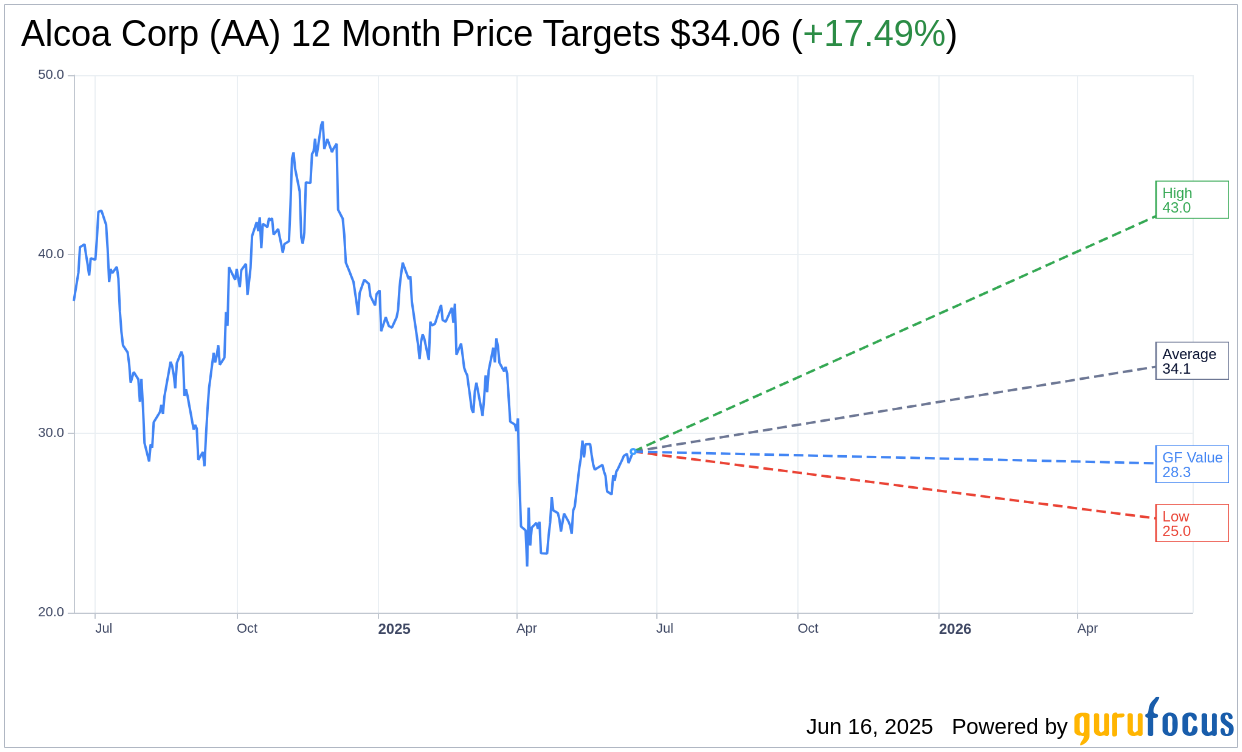Alcoa (AA, Financial) is experiencing a surge in call option trading, with 6,178 calls exchanged, exceeding expectations by 10%. The implied volatility for the stock has also climbed by nearly 2 points, reaching 55.28%. The most traded options are the Jun-25 call options at strike prices of 30 and 31, collectively accounting for close to 3,100 contracts. The Put/Call Ratio currently stands at 0.63, indicating a higher preference for call options. Investors are eyeing the company's upcoming earnings report, scheduled for July 16th.
Wall Street Analysts Forecast

Based on the one-year price targets offered by 9 analysts, the average target price for Alcoa Corp (AA, Financial) is $34.06 with a high estimate of $43.05 and a low estimate of $25.00. The average target implies an upside of 17.49% from the current price of $28.99. More detailed estimate data can be found on the Alcoa Corp (AA) Forecast page.
Based on the consensus recommendation from 12 brokerage firms, Alcoa Corp's (AA, Financial) average brokerage recommendation is currently 2.3, indicating "Outperform" status. The rating scale ranges from 1 to 5, where 1 signifies Strong Buy, and 5 denotes Sell.
Based on GuruFocus estimates, the estimated GF Value for Alcoa Corp (AA, Financial) in one year is $28.29, suggesting a downside of 2.41% from the current price of $28.99. GF Value is GuruFocus' estimate of the fair value that the stock should be traded at. It is calculated based on the historical multiples the stock has traded at previously, as well as past business growth and the future estimates of the business' performance. More detailed data can be found on the Alcoa Corp (AA) Summary page.
AA Key Business Developments
Release Date: April 16, 2025
- Revenue: $3.4 billion, down 3% sequentially.
- Net Income: $548 million, up from $202 million in the prior quarter.
- Earnings Per Share (EPS): $2.07, more than doubling from the previous quarter.
- Adjusted Net Income: $568 million, or $2.15 per share.
- Adjusted EBITDA: $855 million, an increase of $178 million.
- Cash Balance: $1.2 billion at the end of the first quarter.
- Free Cash Flow: Positive, with contributions from net non-controlling interest.
- Return on Equity: 39.1% year-to-date.
- Days Working Capital: Increased to 47 days, up 13 days sequentially.
- Debt Issuance: $1 billion in Australia, with $890 million tendered for 2027 and 2028 notes.
- Adjusted Net Debt: $2.1 billion at the end of the first quarter.
- Dividend: $26 million added to stockholder capital returns.
- US Section 232 Tariffs: Estimated annual cost of $400 million to $425 million, with a net negative impact of approximately $100 million.
For the complete transcript of the earnings call, please refer to the full earnings call transcript.
Positive Points
- Alcoa Corp (AA, Financial) reported strong first-quarter financial and production results, with no fatal or serious injuries, highlighting a strong safety culture.
- The company completed a $1 billion debt offering in Australia, extending maturities at a lower after-tax interest expense.
- Alcoa Corp (AA) formed a joint venture with IGNIS EQT for the San Ciprián operations, resuming production at the smelter.
- First-quarter net income attributable to Alcoa was $548 million, with earnings per share more than doubling to $2.07.
- The company ended the first quarter with a cash balance of $1.2 billion, supported by strong EBITDA and positive cash flow from operations.
Negative Points
- Revenue decreased by 3% sequentially to $3.4 billion, with a notable decline in the aluminum segment due to lower average realized prices and shipments.
- The US Section 232 tariffs on Canadian aluminum imports increased to 25%, resulting in an estimated annual negative impact of $100 million on Alcoa's business.
- The Alumina segment's adjusted EBITDA decreased by $52 million due to lower alumina prices and unfavorable currency impacts.
- The Aluminum segment's adjusted EBITDA decreased by $60 million, impacted by higher alumina costs and increased production, energy, and raw material costs.
- Working capital increased significantly in the first quarter, driven by higher raw material prices and volumes, leading to elevated inventory levels.
